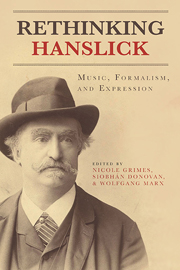Book contents
Foreword by Mark Evan Bonds
Published online by Cambridge University Press: 05 July 2013
Summary
Any serious account of musical criticism or aesthetics in the nineteenth century has to confront Eduard Hanslick at some point. For more than forty years, he was the leading music critic in Vienna, one of Europe's cultural capitals, and his brief treatise on aesthetics, Vom Musikalisch-Schönen, remains the central document in the history of the concept known as “absolute music,” the idea of music as a wholly self-referential art of pure form.
But music was about more than music in Hanslick's Vienna, as he himself well knew. It was a cultural battlefield that pitted defenders of the city's musical past—Haydn, Mozart, and Beethoven, or at least the Beethoven of the first eight symphonies—against the advocates of the “Music of the Future,” who considered Beethoven's Ninth the fountainhead for the new music of Wagner and Liszt. Both as a critic and as an aesthetician, Hanslick was on the front line of battle, leading a war of words against those who considered the forms of the past superseded and inadequate to the demands of the present. Vom Musikalisch-Schönen provided traditionalists with a philosophical argument by which to justify their rejection of the “Music of the Future” on the basis of something more than merely personal dislike of the new music or resistance to change in general.
- Type
- Chapter
- Information
- Rethinking HanslickMusic, Formalism, and Expression, pp. vii - xPublisher: Boydell & BrewerPrint publication year: 2013

